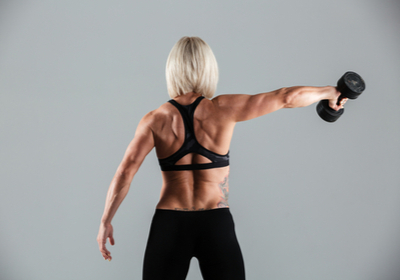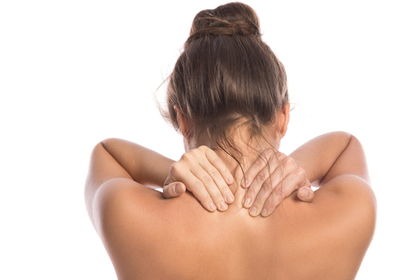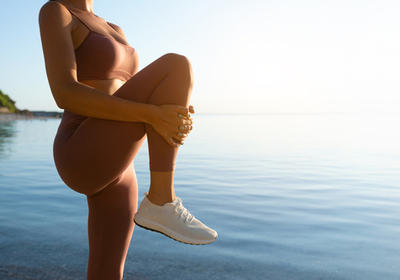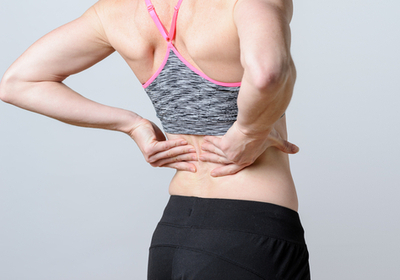VIDEO
Glute Bridge, Single Leg Glute Bridge, Donkey Kicks Variation
- Core
- Back
- Legs
- Abs
Level:Intermediate
Trainer:Cara Richardson
Equipment:Fitness Mat
Glute Bridge, Single Leg Glute Bridge, Donkey Kicks Variation
- Core
- Back
- Legs
- Abs
Level:Intermediate
Trainer:Cara Richardson
Equipment:Fitness Mat
1.Lay back on a mat with your knees bent and your palms on the ground. Start moving your gluteus up and down in a smooth and slow tempo. 2. Lay back on the mat with feet flat on the ground and knees bent. Extend one leg and swinging it from side to side, start lifting your hips off the ground until your knees, hips, and shoulders form a straight line. Try to squeeze your gluteus hard, keeping your abs drawn in order to not overextend your back during the exercise. 3. Stand with your knees and hands on the ground (or you may use a step or a bench). Keeping your arms straight, lift your right leg up, then put it down and repeat with the left leg.
save to ...
RECOMMENDED FOR YOU
- Core
- Legs
- Gluteus
Duaration: 00:15
save to playlist
- Abs
- Lower Back
- Gluteus
Duaration: 00:15
save to playlist
- Core
- Legs
- Abs
Duaration: 00:14
save to playlist
- Core
- Biceps
- Triceps
Duaration: 00:15
save to playlist
- Core
- Arms
- Back
Duaration: 00:15
save to playlist
- Core
- Arms
- Legs
Duaration: 00:15
save to playlist
- Core
- Arms
- Back
Duaration: 00:15
save to playlist
- Core
- Arms
- Legs
Duaration: 00:15
save to playlist
- Core
- Arms
- Back
Duaration: 00:15
save to playlist
- Core
- Legs
- Abs
Duaration: 00:15
save to playlist
- Core
- Arms
- Legs
Duaration: 00:14
save to playlist
- Core
- Back
- Legs
Duaration: 00:15
save to playlist
- Core
- Arms
- Legs
Duaration: 00:15
save to playlist
- Core
- Arms
- Legs
Duaration: 00:15
save to playlist
- Core
- Legs
- Abs
Duaration: 00:14
save to playlist
- Core
- Arms
- Legs
Duaration: 00:15
save to playlist
Blog
Upper back muscles are extremely important for the right posture, yet many people completely forget about these muscles while working out, which is a big mistake. So why are these muscles so important, and how to train them? These are the questions we will attempt to answer in this article.
What Is Upper Back?
The muscles of the upper back consist of two main parts, which are the trapezius and latissimus muscles. Apart from that, many experts also involve the back bundles of deltas in the upper back muscle group since they are involved in most workouts for the upper back muscles. At the same time, referring to these muscles as a part of the upper back is incorrect from the anatomical point of view.
The main function of the trapezius muscles is to provide the movement of the shoulder blades as well as make it possible to raise arms and lift objects. These muscles are also rather important for our posture as well as the ability to keep our back straight. At the same time, the latissimus muscles are located on both sides of the back. They resemble wings in shape and occupy almost the entire back area. These muscles are needed to pull the arms back as well as bring the shoulders to the body.
Why Do I Need to Develop My Upper Back?
So we have already figured out that the upper back muscles are responsible for the right posture as well as the ability to raise arms and lift objects, but who needs to work on their upper back? Well, a strong upper back is perhaps one of the main goals for everyone. In particular, among the people who need to work on their upper back are:
Office workers who work all day at the desk
Professional dancers and dance enthusiasts who need a strong back and perfect posture
Athletes who actively involve the neck, shoulder, and back muscles while doing their sports activities
Fitness enthusiasts and bodybuilders who strive to grow muscles and harmoniously develop all muscle groups
People who want to have a nice posture
So do you belong to any of these groups? We bet you do. So make sure to add at least a few upper back exercises into your workout routine.
Best Exercises for Upper Back
To wrap up, we would like to provide you with some useful workouts for your upper back, so without any further ado, here they come:
Reverse fly
Bent over barbell row
Barbell high rows
Single-arm dead stop row
T-pulls
TRX row
Upright row
Single-arm landmine row
Y-pulls
Face pull
Seated row
Hang clean
Renegade row
These simple exercises will help you develop your upper back muscles quickly and stress-free, so make sure to give them a try.
Wrapping Up
Developed upper back muscles are essential for the right posture as well as for avoiding injuries while doing other sports activities. So no matter if you are a professional athlete or not, you still need to work on these muscles.
Read more
Trapezius muscles are often underestimated, and many people don’t pay much attention to them while working out. However, it is a huge mistake because these muscles are extremely important for the right posture as well as back health. So in this article, we’ll talk about trapezius muscles and how to develop them.
Why Do I Need to Work on Trapezius Muscles?
The trapezius is a part of the upper back which helps us to maintain the right posture. The muscle group consists of three different parts, which are top, medium, and bottom. Together with the muscles of the neck, the trapezius is responsible for the right posture. The upper part of this muscle is responsible for the rise of the shoulder as well as the ability to lift arms. The lower one - is for lowering shoulders and arms. At the same time, the middle one is needed for blade movement. As you can see, this muscle group is responsible for many basic functions, which is why developing the trapezius muscles is extremely important for everyone, especially for those people who have some problems with their posture.
How Often Should I Do Trapezius Workouts?
Ideally, you have to include at least 2-3 trapezius exercises in each workout session. At the same time, you have to work out 3 times a week. In some cases, it’s better to have 4 training sessions per week. In case you have some issues with your posture and you cannot keep your back straight because your spine muscles (especially trapezius) are weak, we recommend doing at least a few exercises for trapezius muscles every day.
Who Needs Trapezius Exercises the Most?
Of course, everybody needs to straighten their trapezius muscles, but, obviously, some people need it more than others. So who are those people? Well, here is a short list of those you must pay more attention to their trapezius muscles:
Office workers who work long hours at the desk
People who have posture problems and struggle to keep their back straight
Athletes and fitness enthusiasts who lift heavy weights
Boxers, volleyballers, basketballers, and other sportsmen who actively involve their arms in their sports activity
Dancers and gymnasts who need strong and developed back muscles
Do you belong to any of these groups? Then you better start working on your trapezius muscles now.
Best Workouts for Trapezius
Last but not least, we would like to recommend you some trapezius workouts, so here they come:
Shrug
Deadlift
Shoulder blade squeeze
Barbell row
Upright row
Reverse dumbbell flyes
Chin-up
Pull-up
Push-up
Lat-pulldown
Rear delt cable raise
High pulley cable row
Overhead farmer's walk
Y raise
Rope rear delt pull
Wrapping Up
Trapezius muscles are super important for your back health, so no matter what your occupation is or how often you work out, you still need to find at least a few minutes for some exercises for the trapezius.
Read more
People often underestimate hamstrings. Often, focusing on training the quadriceps and calves, hamstrings seem less important. However, you should remember that neglecting any muscle has aesthetic and medical consequences that can be avoided if you work it properly. The reason you shouldn't ignore these muscles is not just about the symmetry and appearance of your body. Hamstring weakness is one of the most common causes of injury in most professional athletes.
The best way to strengthen your leg muscles is to work them out properly. So let's have a look at the exercises.
Barbell 90
The main advantage of this exercise is that you don't need much equipment, just a simple barbell. Starting in a standing position and holding the barbell on your shoulders, keep your back straight. While bending your knees slightly, tense your hips, and bend forward 90 degrees. Then return to the starting position inhaling. Except for hamstrings, this exercise will also strengthen your hips and back.
Hyperextensions
Hyperextensions are a great workout for your hamstrings as well as the lower back and glute muscles. Sit on the hyperextension training machine comfortably with your heels pressed against the platform at the bottom of the trainer. Place your arms crossed in front of your chest or behind your head. Slowly lower yourself down until you inhale and feel the stretch in your lower back and leg muscles. Without stopping at the bottom point, straighten up to the starting position and exhale. Return to the beginning position then. Maintain your head in line with your torso, keeping your back straight throughout the exercise.
Tights Up
This exercise can be done on the playground with two pull-ups or simply by placing your feet on a chair or bench. We will present a variation of the home exercise.Choose a sitting position on the floor with your feet on a chair. Lift your torso with your hands so that the tights are in the air. Bending your knees, raise the tights so that your body is paralleled to the floor. Perform 7-8 repetitions.
Single-Leg and Dumbbell
The exercise requires a good sense of balance and gives you good results. With a dumbbell in your hand, bring one leg back and keep it on the floor until the end of the exercise. Then return to the previous position. Repeat this exercise several times before you have tired.
Final Words
Hamstrings may look insignificant, but that has nothing to do with the fact that you can skip working these muscles. As a matter of fact, stronger hamstrings prevent you from many injuries. Therefore, don't delay and start exercising these muscles now.
Read more
Lower back muscles easily get sore and injured as well as are rather challenging to train. At the same time, these muscles are essential for one’s back health. So what is the anatomy of lower back muscles, and how to develop them? This is exactly what we are going to talk about in this article.
Lower Back Muscles: Anatomy & Functions
The lower back muscle group consists of several muscles, which are multifidus muscles, erector spinae, spinalis, and latissimus dorsi. These muscles are essential for posture, moving, and even involved in the walking process. In fact, lower back muscles are super important for normal functioning, and those people who have suffered any lower back injuries know it. In addition to that, these muscles are actively involved in the special moves in certain sports like gymnastics as well as in various dance styles. So even though these muscles seem to be small and unimportant, yet they actually have lots of functions.
Why Is It Important to Develop Your Lower Back Muscles?
Many people believe that, in terms of the spine, you only need to work on the trapezius and upper back since these muscles are essential for the right posture. Certainly, it’s not exactly true. In fact, you have to work on your entire spine to harmoniously develop all the muscles of your back. Plus, the lower back easily gets injured, especially if you lift something heavy, but if you have strong and developed lower back muscles, you can reduce the risks of having such an injury. So no matter if you are an office worker or a professional athlete or dancer, you need to work on your lower back muscles.
Workouts for the Lower Back Muscles
So how can you make your lower back muscles stronger and therefore lower your chances of getting a nasty injury? Well, here are some exercises you might want to try:
Rack pull
Harvesting apples
Bent over row
Side stretching
Barbell good morning
Belly roll
Back extension
Side plank
Superman
Glute hamstring raise
These simple exercises will no doubt help you make your lower back stronger and healthier, so do not hesitate and give them a try.
Final Thoughts
Developed lower back muscles are not only needed for professional athletes or dancers but also for those people who want to maintain their back health. So make sure to include at least a few lower back workouts into your exercise routine. Trust us, you won’t regret it.
Read more
Did you know that the deltoid muscle is composed of three parts? Therefore, in order to train more effectively, we need to pay attention to each of them. By doing so, harmonious development of the deltoid muscle is possible. Therefore, the goal is to perform special exercises so that the function of each ligament of the deltoid muscle is involved during training.
If you want to strengthen your deltoid muscles, you need to train them regularly, so we recommend that you do these exercises for the deltoid muscles
Side Dumbbells
If you want to develop the posterior deltoids in your shoulders, this is a great exercise to do. It not only works with the deltoids but also the obliques.Hold the dumbbells with a neutral grip and perform bending forward a little keeping your back straight, at this time the dumbbells should be raised to the level of your ears.
Front Pull-Up
This exercise is great for training the upper body and abdominal obliques.In a seated position, hold a dumbbell in each hand. Lower your arms. Next, raise the dumbbells so that they are parallel to the floor. As you do so, keep your arms straight. When they reach shoulder height, stop. Lower the dumbbells in the same manner. Do the same with the other arm.
Lifting to the Side
Experts recommend performing these exercises to effectively train the outer deltoid muscles. The effectiveness of your training depends on proper practice, so follow these instructions exactly. Hold a dumbbell in each hand and stand up straight. Now slowly lift the dumbbells. When the dumbbells reach shoulder height, hold them there. Then lower the hands slowly and return to the position from the start.
Bench Press
Place the barbell on your chest and bring your elbows forward while tensing your abs, glutes, and legs. Repeat lifting and lowering the barbell, then lifting and lowering again.Do not lift as the bar passes over your face, but lower it toward you for optimal trajectory.If the bar remains in front of you instead of over your body at the apex, you will increase the load on your lower back. Try lifting the bar behind your head. Perform 3-5 sets of 6-8 movements each.
Free Arm Pushups
The exercise itself is a repetition of a smaller range of push-ups with the barbell raised.Stand in an inverted position with your feet against the wall. Bend your elbows to lower your body and place your head on the floor. Lower your head backward and repeat. Be careful when lowering your head to the floor (any unintentional movement can injure your neck).Placing a blanket or thick book under your head will make the exercise more effective.To make it more difficult, place some kind of solid support under your arms. The more reps you do in a set, the better. Perform 3-5 sets, depending on your mood.
Developing your deltoid muscles will improve your athleticism and give you a beautiful body, so if you dream of a beautiful body, please do these exercises.
Read more
SAVE TO ...





